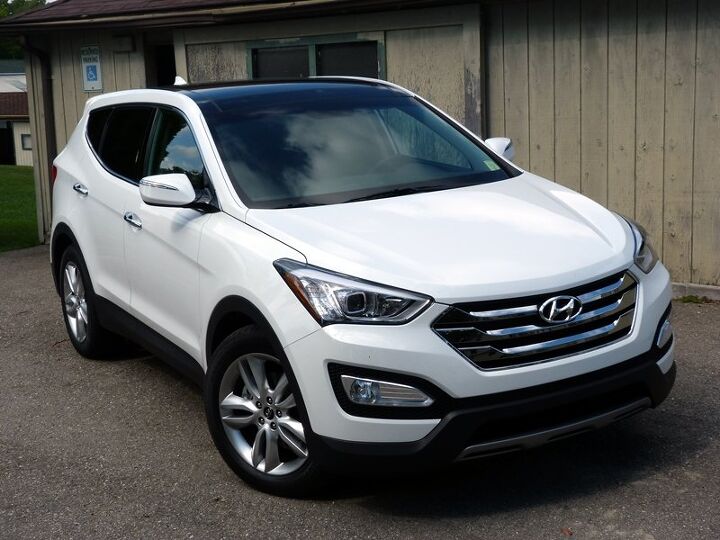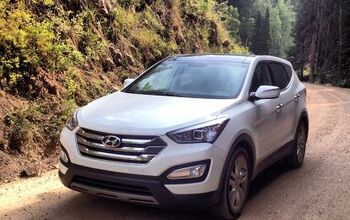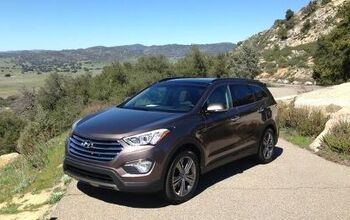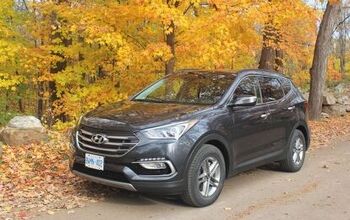Review: 2013 Hyundai Santa Fe Sport
On paper, there’s no contest. For the same price as the new Ford Escape, the even newer Hyundai Santa Fe Sport includes a longer warranty, more power, and a much roomier interior. But if such comparisons could be decided from the spec sheets alone, auto reviewers would have to find a new line of work.
You might have noticed some similarities between Hyundai’s and Ford’s most recent designs. Both follow a “more is more” philosophy in their rush to offer the look of 2025 today. With the Santa Fe Sport, oversized facial features and an undersized greenhouse collaborate to visually pump up overhangs already a half-foot longer than the Escape’s (on a nearly identical wheelbase). For those seeking less roided proportions (or two more seats), the Santa Fe Sport will soon be joined by a three-row Santa Fe (sans Sport).
Inside, the Santa Fe Sport has the cleaner, more restrained design of the two, such things being especially relative in this case. There’s plenty of visual sci fi in the center stack, but it doesn’t intrude as deeply into the passenger compartment. Nor is the instrument panel as deep are as tall, contributing to a more open view forward. Hyundai keeps upgrading its materials. The new Santa Fe Sport’s are better than those in the Sonata, if not quite a match for those in the Azera. If Ford has an edge here, it’s a slender one.
The Santa Fe Sport isn’t roomier than the Escape only through its interior design. It simply contains more space inside, about 3.5 more inches for both shoulders and legs. For a family of five people tall enough to see out of the Hyundai’s rear side windows, the choice between the two would be easy. Despite the Hyundai’s plumper posterior, the two are more evenly matched in terms of cargo volume (if the official specs are roughly comparable, which they often aren’t).
Hyundai is rightly proud of the over three hundred pounds the crossover lost with this redesign. The Santa Fe Sport might be considerably larger than the Ford Escape, but it’s no heavier. With 2.0T engines and all-wheel-drive, both weigh a little over 3,700 pounds. Drop the turbo and all-wheel-drive from the SFS, and the 190-horsepower 2.4-liter four-cylinder engine has so little trouble motivating 3,459 pounds that the boosted uplevel engine seems unnecessary…until you drive it, then the 264-horsepower 2.0T’s much stouter (if less even) midrange becomes readily evident. Despite being down 24 horsepower and hitched to a less decisive six-speed automatic transmission, the Escape’s engine feels even more energetic and more responsive.
Turbocharged four-cylinder engines allegedly have a significant fuel economy advantage over V6s. If I had written this review a few weeks ago, I’d have relayed EPA ratings of 20 city and 27 highway for the Santa Fe Sport 2.0T AWD. But, as you might have heard, “procedural errors” in Hyundai’s testing led it to report inflated fuel economy figures. Because the miscalculation involved aerodynamic drag, the subsequent adjustment has had the largest impact on crossovers’ highway ratings. The SFS’s numbers have been shaved from 20/27 to a far less competitive 19/24. The antiquated, 350-pound-heavier, V6-powered 2012 Santa Fe managed 20/26. Suddenly the economy benefits of boost aren’t so apparent. The Escape 2.0T AWD checks in at 21/28.
Science experiment: which most affects handling, size or curb weight? This comparison between equally hefty vehicles suggests size. The Santa Fe Sport might weigh about the same as the Escape, but it feels much bulkier. Not that the Hyundai handles badly. Body motions over wavy pavement and roll in turns are both much better controlled than in the previous Santa Fe. As in the Escape (though here only with AWD), torque vectoring via selective application of the brakes limits understeer. You can even select from three different levels of steering assist. Unfortunately, the three levels are light, lighter, and lightest and all of them are equally numb. The more tightly and precisely suspended Escape has its own dynamic flaws (a crossover-high CoG tends to make some key tradeoffs insurmountable), but it does more than handle curves competently. It makes them fun. In comparison, the Santa Fe Sport isn’t sporty.
When I say the two crossovers are the same price, I’m not employing any procedural missteps to massage the numbers. Equip a 2013 Ford Escape SEL with the 2.0T engine, AWD, leather upholstery, panoramic sunroof, and nav, and the window sticker reads $35,625. Do the same with the 2013 Hyundai Santa Fe Sport and the sticker reads…$35,625. TrueDelta’s car price comparison tool gives the Ford a slight ($190) edge in content, so they remain very close even after adjusting for feature differences. Okay, maybe I’m eliding one minor matter. To get 19-inch rims on an Escape you must spend a few hundred more for the Titanium. But adjust for the extra features that attend the higher trim level and it actually ends up a slightly better value.
“Value” might seem out of place in a comparison between mainstream brand compact crossovers with window stickers in the mid-thirties. (I’m having a hard time coming to grips with this myself.) But the Ford provides much of the driving enjoyment of a BMW X3 for about $10,000 less. On paper, the Santa Fe Sport should perform at least as well, but subjectively it’s a different animal. That fierce face is only skin deep. In how it drives, the Santa Fe Sport aims for the heart of the market, more athletic than a Chevrolet, Honda, or Toyota but unlikely to elicit comparisons to BMWs. The Hyundai’s value appeal is similarly conventional: same price, more car. More fun or more inches, what’s your preference?
Both cars were provided with fuel and insurance by their manufacturers. Hyundai also provided lunch.
Michael Karesh operates TrueDelta.com, an online source of car reliability and pricing information.
Michael Karesh lives in West Bloomfield, Michigan, with his wife and three children. In 2003 he received a Ph.D. from the University of Chicago. While in Chicago he worked at the National Opinion Research Center, a leader in the field of survey research. For his doctoral thesis, he spent a year-and-a-half inside an automaker studying how and how well it understood consumers when developing new products. While pursuing the degree he taught consumer behavior and product development at Oakland University. Since 1999, he has contributed auto reviews to Epinions, where he is currently one of two people in charge of the autos section. Since earning the degree he has continued to care for his children (school, gymnastics, tae-kwan-do...) and write reviews for Epinions and, more recently, The Truth About Cars while developing TrueDelta, a vehicle reliability and price comparison site.
More by Michael Karesh
Latest Car Reviews
Read moreLatest Product Reviews
Read moreRecent Comments
- Rover Sig 2021 Jeep Grand Cherokee Limited, like my previous JGC's cheap to keep (essentially just oil, tires) until recent episode of clunking in front suspension at 50K miles led to $3000 of parts replaced over fives visits to two Jeep dealers which finally bought a quiet front end. Most expensive repair on any vehicle I've owned in the last 56 years.
- Bob Hey Tassos, have you seen it with top down. It's a permanent roll bar so if it flips no problem. It's the only car with one permanently there. So shoots down your issue. I had a 1998 for 10 years it was perfect, but yes slow. Hardly ever see any of them anymore.
- 3-On-The-Tree 2007 Toyota Sienna bedsides new plugs, flat tire on I-10 in van Horn Tx on the way to Fort Huachuca.2021 Tundra Crewmax no issues2021 Rav 4 no issues2010 Corolla I put in a alternator in Mar1985 Toyota Land Cruiser FJ60 280,000mi I put in a new radiator back in 08 before I deployed, did a valve job, new fuel and oil pump. Leaky rear main seal, transmission, transfer case. Rebuild carb twice, had a recall on the gas tank surprisingly in 2010 at 25 years later.2014 Ford F159 Ecoboost 3.5L by 80,000mi went through both turbos, driver side leaking, passenger side completely replaced. Rear min seal leak once at 50,000 second at 80,000. And last was a timing chain cover leak.2009 C6 Corvette LS3 Base, I put in a new radiator in 2021.
- ChristianWimmer 2018 Mercedes A250 AMG Line (W177) - no issues or unscheduled dealer visits. Regular maintenance at the dealer once a year costs between 400,- Euros (standard service) to 1200,- Euros (major service, new spark plugs, brake pads + TÜV). Had one recall where they had to fix an A/C hose which might become loose. Great car and fun to drive and very economical but also fast. Recently gave it an “Italian tune up” on the Autobahn.
- Bd2 Lexus is just a higher trim package Toyota. ^^














































Comments
Join the conversation
"The color options are very limited. You essentially can only pick this car in black, white, or silver. The other colors range from garish to fugly." The maroon is pretty astounding, as well as the brown. Not too shabby of a choice.... I too am disappointed with the panoramic roof set-up. I need a luggage rack. Oddly, you can get one with the panoramic roof on the Kia twin. Style over substance. It'll be interesting to see how the RAV-4 and Forester come to market, although they are a half-size smaller.
I like the front & rear appearance of the SFS...even the side view...oh, wait...until the eye follows that radically-pinched greenhouse to the D-pillar, as in Murano, Rogue, Traverse. A belt line which follows the contour of the prominent body-side crease would have been an elegant & visually balanced solution. With this type of restricted visibility, it's amazing that a backup camera isn't standard equipment!